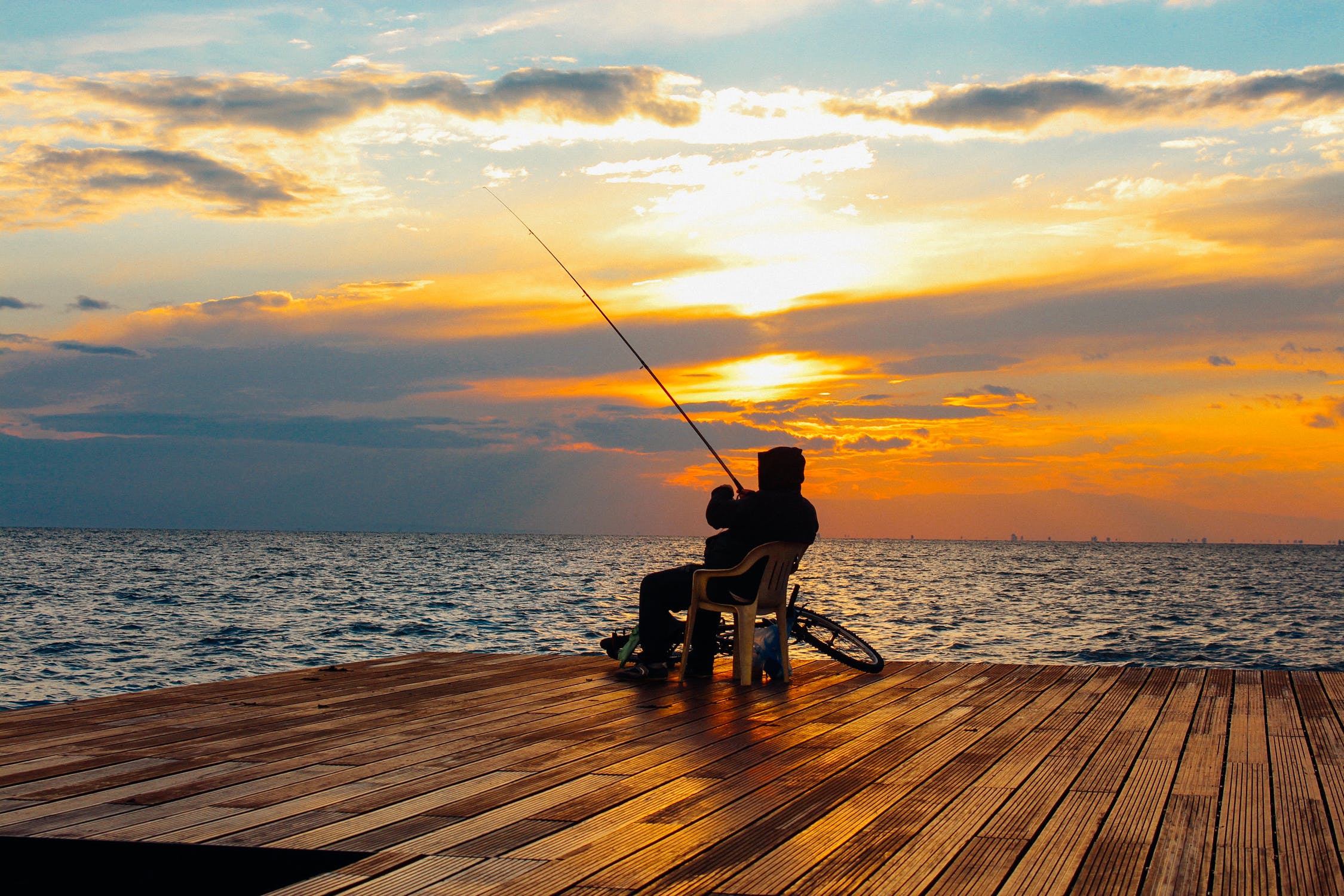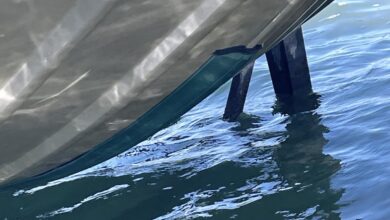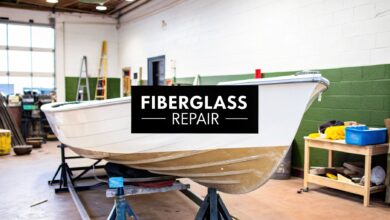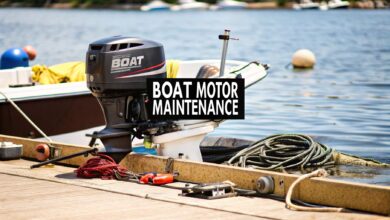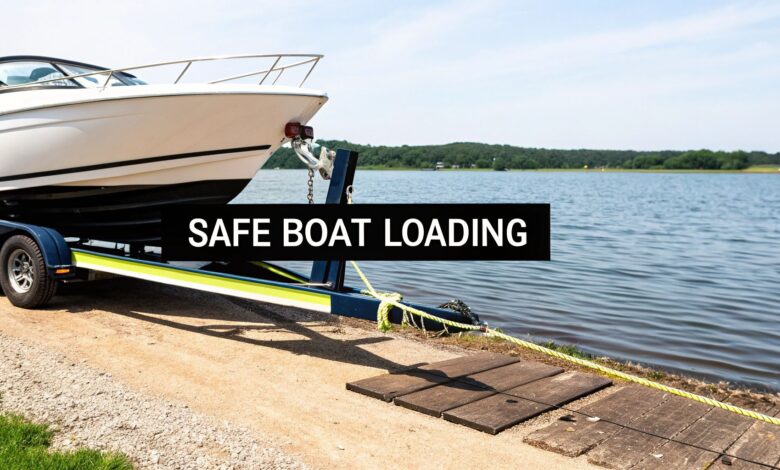
The secret to a stress-free boat loading experience? It all happens before your trailer even gets wet. Seriously. Taking a few minutes to get everything squared away in the staging area is what separates a smooth, quick retrieval from a comedy of errors that holds up the whole ramp.
Prepare at the Staging Area, Not the Ramp
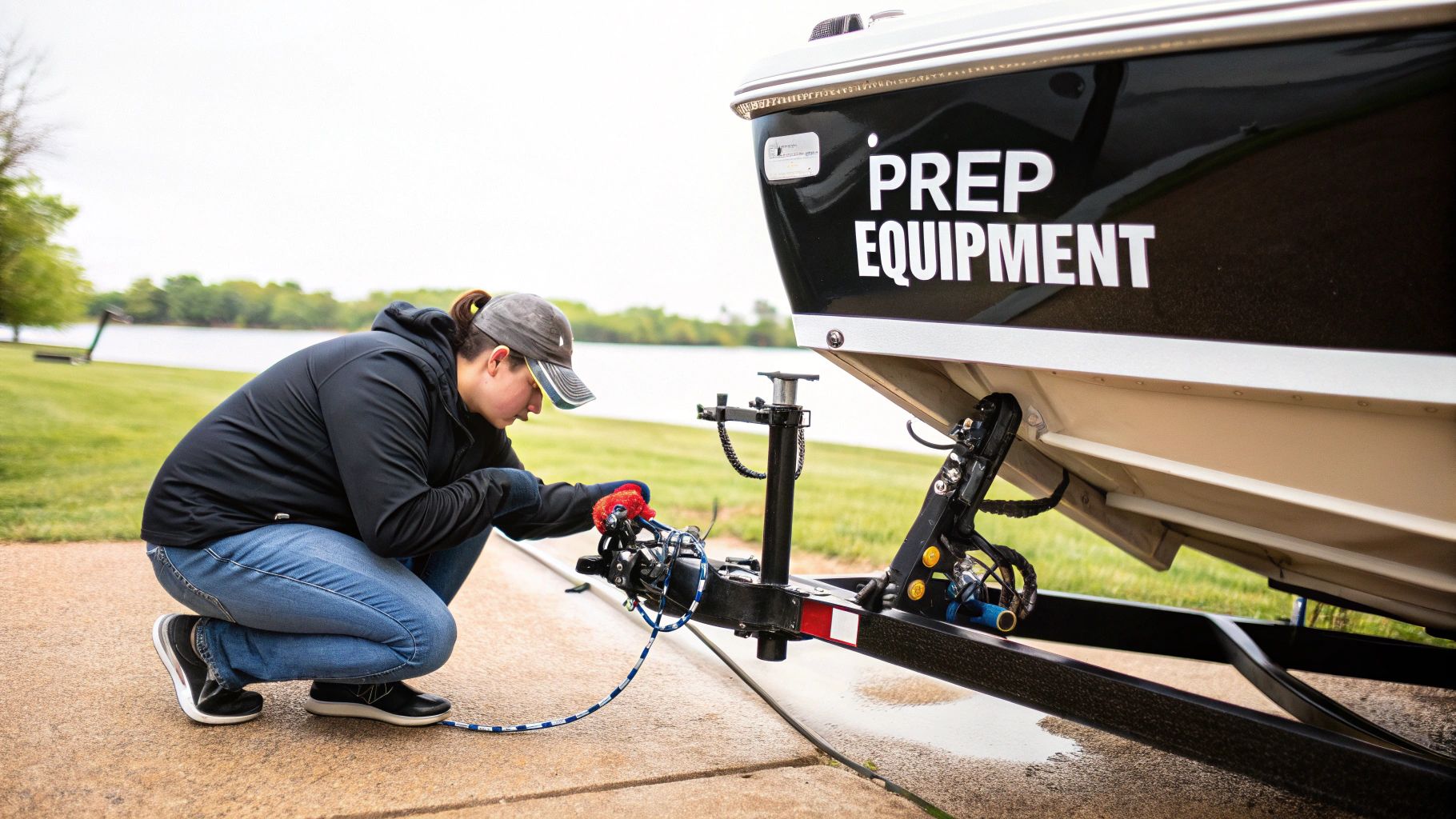
Think of the boat ramp as a shared, fast-moving workspace. Doing all your setup in the designated staging or parking lot—well away from the water's edge—isn't just good manners; it's the bedrock of a successful load-out. This simple act of courtesy prevents a traffic jam and gives you the space to work without feeling the pressure of a dozen sets of eyes watching you.
Before you even think about backing down that ramp, do a quick but thorough pre-loading check. This is not the moment you want to find a flat trailer tire or a winch strap that’s seen better days. A simple walk-around can save you a world of hurt.
Your Pre-Loading Checklist
First things first, get your trailer ready to receive the boat. Go ahead and get all those tie-down straps unhooked and tucked away so they don't get tangled or run over.
From there, get your winch strap sorted out:
- Pull out enough slack so the hook can easily reach your boat's bow eye.
- Make sure the strap isn't twisted or caught on anything.
- Unplug your trailer lights! Submerging hot bulbs in cold water is a great way to break them.
Now, turn your attention to the boat. Get your bow and stern lines attached to the cleats. These ropes are your lifeline for controlling the boat as you approach the trailer. It’s also smart to have your fenders out and ready, just in case you need to tie up to the dock for a minute while you wait for the ramp to clear.
Pro Tip: I like to attach one end of my main bow line to the boat's cleat and the other end to the trailer's winch stand. This creates a safety tether, stopping the boat from drifting away if I overshoot the trailer on my first approach.
The Importance of a Proper Trailer Setup
Modern trailers have come a long way, with adjustable rollers and bunk systems designed to cradle your specific hull. This isn't just for convenience; it's a critical safety feature. In fact, the boat trailer market in North America hit a 54% market share back in 2020, largely driven by these safer, more customized designs.
Taking a moment to double-check that your bunks or rollers are correctly aligned for your boat is non-negotiable. Loading a boat onto a poorly configured trailer can damage the hull and create an unstable, unsafe situation on the road.
When you're well-prepared, you're confident. By following these steps and checking out these other tips for trailering a boat, the whole process becomes second nature. Once your boat and trailer are fully prepped, you can back down the ramp knowing you've set the stage for a perfect landing.
Position Your Trailer for a Perfect Landing
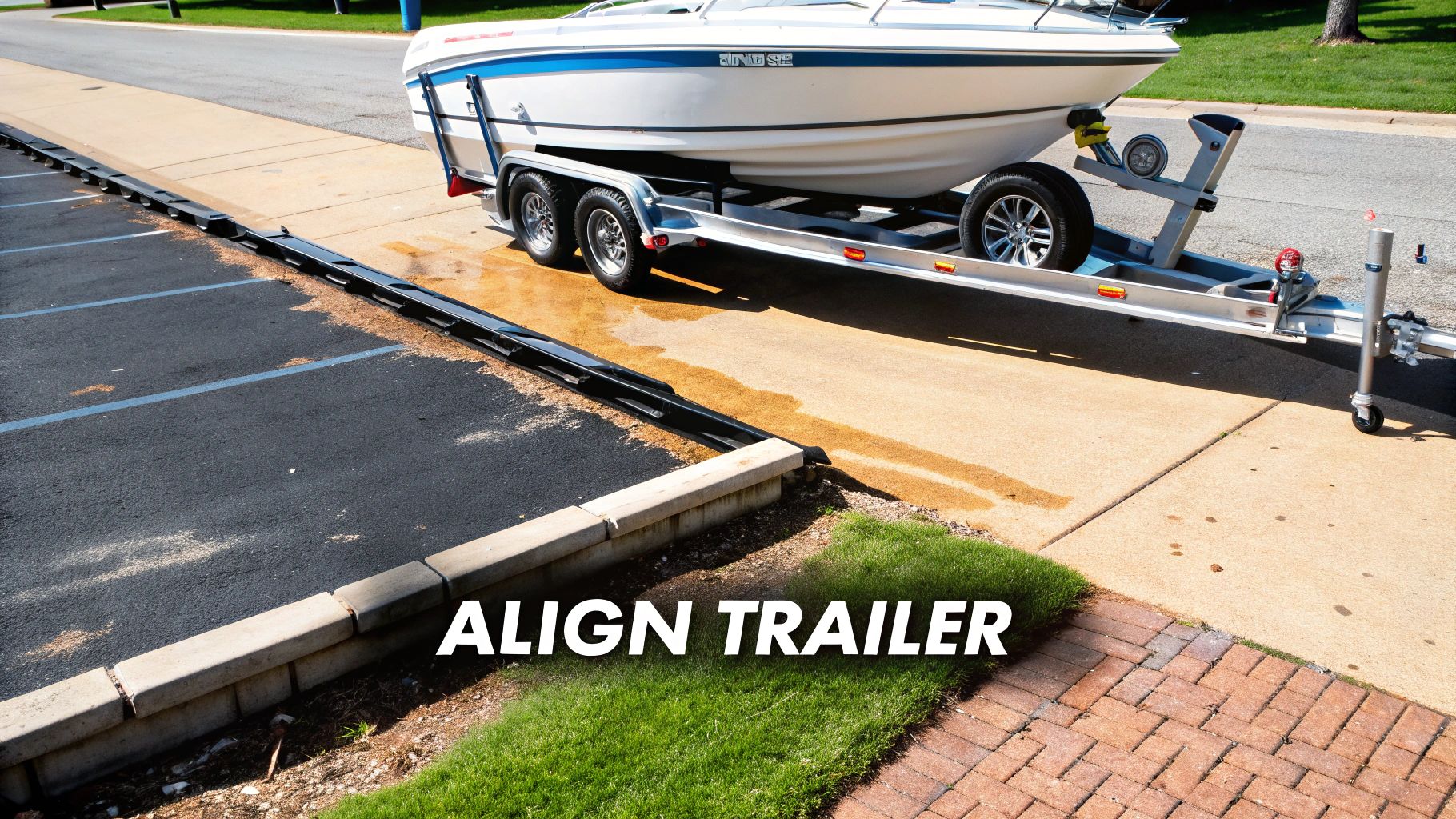
With all the prep work behind you, it's time to back down the ramp. This is where a little bit of finesse makes all the difference. Honestly, the single biggest secret to loading a boat smoothly is getting the trailer depth just right. It's the make-or-break moment.
Your mission is to get the trailer deep enough for the boat to float onto the bunks, but not so deep that it’s just floating aimlessly over them. A boat that's swimming freely above a sunken trailer is a surefire way to end up crooked. You want the trailer's bunks to do the hard work of guiding the boat into its proper spot.
Finding the Sweet Spot
For most standard bunk trailers, a great rule of thumb is to submerge the bunks about two-thirds of their length into the water. The easiest visual cue? You should still be able to see the tops of your trailer’s fenders peeking out above the surface. This depth is the magic formula that lets the boat’s keel find the center while the bunks provide the support to slide it right into place.
If you're working with a roller trailer, you've got a little more leeway. They are designed to actively center the hull, so you can often back them in a bit deeper without any trouble.
Regardless of your trailer type, slow and steady wins the race here. Use your mirrors constantly to keep the trailer straight as you reverse down the ramp. If you have a friend with you, this is their time to shine as a spotter.
I see this all the time: people back way too far into the water, thinking it'll make loading easier. It does the exact opposite. When the trailer is too deep, the boat just floats right over the bow stop and drifts around, making it a nightmare to align.
Communicating and Correcting
Using a spotter isn't just for beginners; it's what smart boaters do. The key is to agree on hand signals before you start backing down. It’ll save you from a classic shouting match at a crowded ramp.
A few simple signals are all you need:
- Thumbs up: Keep coming back.
- Flat palm (like a stop sign): Stop right now.
- Pointing left or right: Turn the wheel this way to straighten the trailer.
Once you’ve hit that perfect depth, shift your vehicle into park and set the emergency brake. It’s always a good idea to hop out and take a quick look to confirm your position. A 10-second check now can save you the headache of pulling all the way out to start over.
With your trailer perfectly positioned, your boat is now set up to glide on smoothly and center itself with hardly any effort. You’ve just staged a flawless retrieval.
Choose Your Boat Loading Method
Alright, your trailer is set and waiting in the water. Now comes the part that often separates the rookies from the old salts: getting the boat onto the trailer. There's no single magic bullet for this; the best way depends on your boat, your confidence level, and what Mother Nature is throwing at you that day.
We'll walk through the three main ways to do it: driving on, winching, and floating it on. Knowing when and how to use each one will make your trips to the ramp smoother and a whole lot less stressful.
Driving On With Controlled Power
The drive-on method is exactly what it sounds like—using your boat's engine to motor right onto the trailer. When you nail it, it's fast and looks impressive. But let's be clear: this takes practice. This isn't about gunning the engine; it's all about slow, controlled momentum.
You'll want to approach the trailer dead-on, nice and slow. As your keel touches the first rollers or the beginning of the bunks, give the throttle a gentle "bump" to start the boat's journey up the trailer. Little steering adjustments are key here to stay centered. Overcorrecting is a common mistake that can send you sideways in a hurry. Often, one good nudge of power is all it takes to get the bow close enough to the winch post.
This image shows just how much the ramp's angle plays into getting the trailer depth right, which is critical for any loading method.
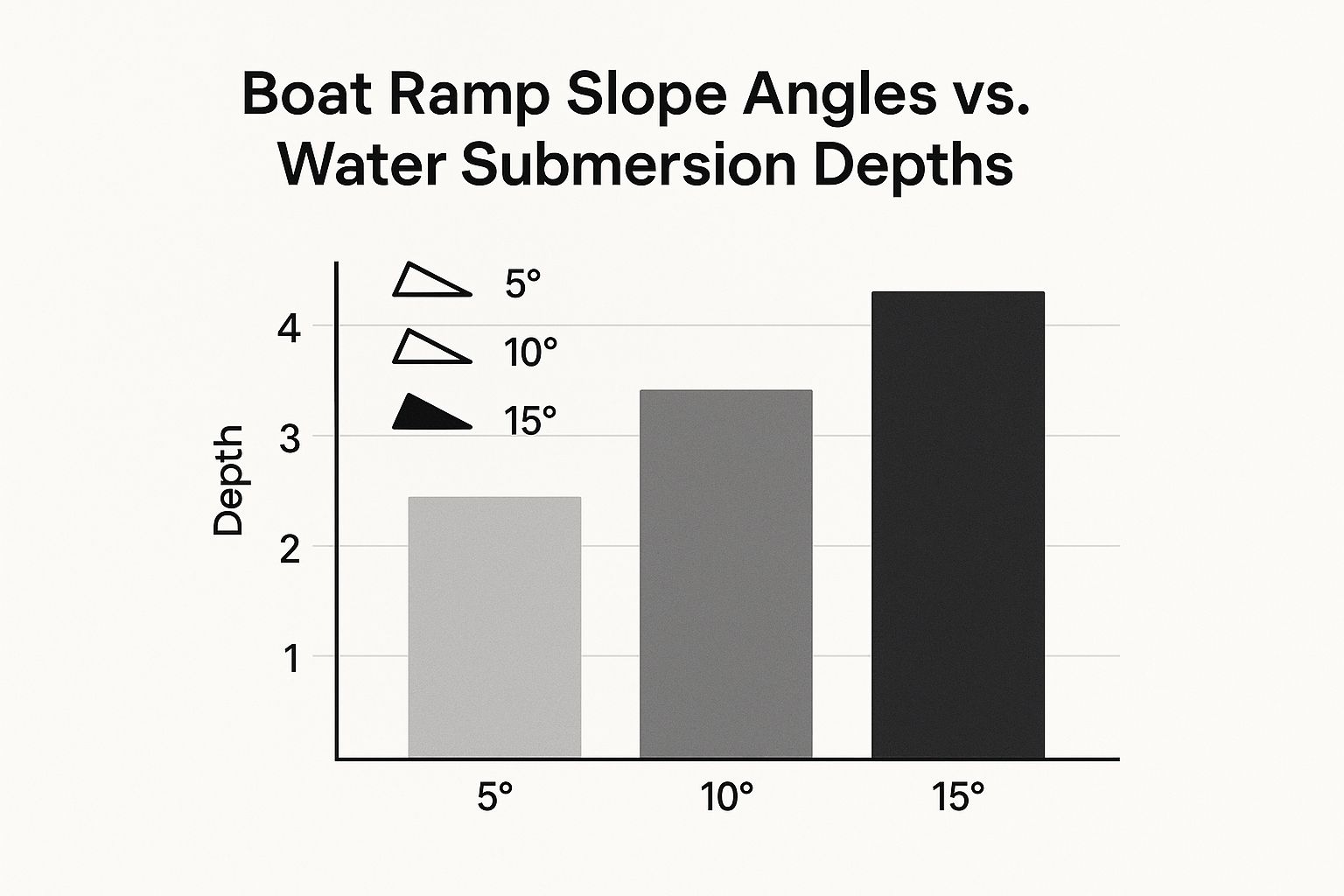
As you can see, a steep ramp means the trailer doesn't have to be as far in the water. On the flip side, a shallow ramp requires you to back in quite a bit more to get the right angle for a smooth load.
Winching On for Maximum Control
For a lot of boaters, especially when it’s windy or a current is pushing you around, winching is the smartest play. It’s definitely slower than driving on, but it gives you way more control and is much safer for your gear. In fact, some boat ramps actually ban power loading because the "prop wash" can dig out the lakebed at the end of the ramp, creating a dangerous drop-off.
The process is simple. Just guide your boat toward the trailer until the bow eye is within arm's reach of the winch strap. If you're working solo, a handy trick is to use a bow line to loosely tie the boat to the winch stand. This keeps it from drifting away while you hop out of the boat and onto the trailer tongue.
From there, it's just a few simple moves:
- Hook It Up: Attach the winch hook to your boat’s bow eye. Double-check that the little safety clasp on the hook is fully engaged.
- Start Cranking: Begin turning the winch handle. You should feel a steady, firm resistance. If you're really having to muscle it, something isn't right—your trailer probably isn't deep enough.
- Keep It Centered: As the boat glides up, glance back a few times to make sure it's staying right in the middle of the bunks.
The winch is meant to pull the boat those last few feet, not to drag it over dry bunks from halfway down the trailer. If you're straining, stop. Don't force it. Just have your driver back the trailer a few more inches into the water to let buoyancy help you out.
The Float-On Technique
The float-on method is a fantastic, low-impact technique, and it's my personal favorite for roller trailers or on calm days. This approach uses guide lines and the boat's natural buoyancy to do most of the heavy lifting for you.
For this one, you'll want the trailer a bit deeper in the water than you would for winching. The idea is to use your bow and stern lines to "walk" the boat into position over the now-submerged bunks or rollers. With a person on the dock or one on each side of the trailer, you can easily pull and nudge the boat until it’s perfectly aligned.
Once the boat is centered and floating right above where it needs to sit, signal your driver to pull the tow vehicle slowly and steadily up the ramp. As the trailer rises out of the water, the boat will settle gently onto the bunks. All that's left is to connect the winch strap and snug the bow up tight against the bow stop. This method is incredibly gentle on your hull and a great one for beginners to build confidence.
Boat Loading Method Comparison
To help you decide which approach is right for you, here’s a quick breakdown of the three methods we've covered.
| Method | Best For | Pros | Cons |
|---|---|---|---|
| Driving On | Experienced boaters, calm conditions, ramps that allow power loading. | Fastest method; very efficient once mastered. | High skill required; risk of damaging boat/trailer; can be prohibited. |
| Winching On | Most boaters, windy/current conditions, bunk trailers. | High degree of control; safer; less stress on equipment. | Slower than driving on; requires more physical effort. |
| Floating On | Beginners, roller trailers, solo loading, calm water. | Very gentle on the hull; easy to align the boat perfectly. | Requires deeper water; can be tricky in wind or current. |
Ultimately, there’s a time and a place for each technique. The best boaters I know are proficient at all three and choose the right one for the situation at hand.
Center Your Boat on the Bunks for a Safe Tow
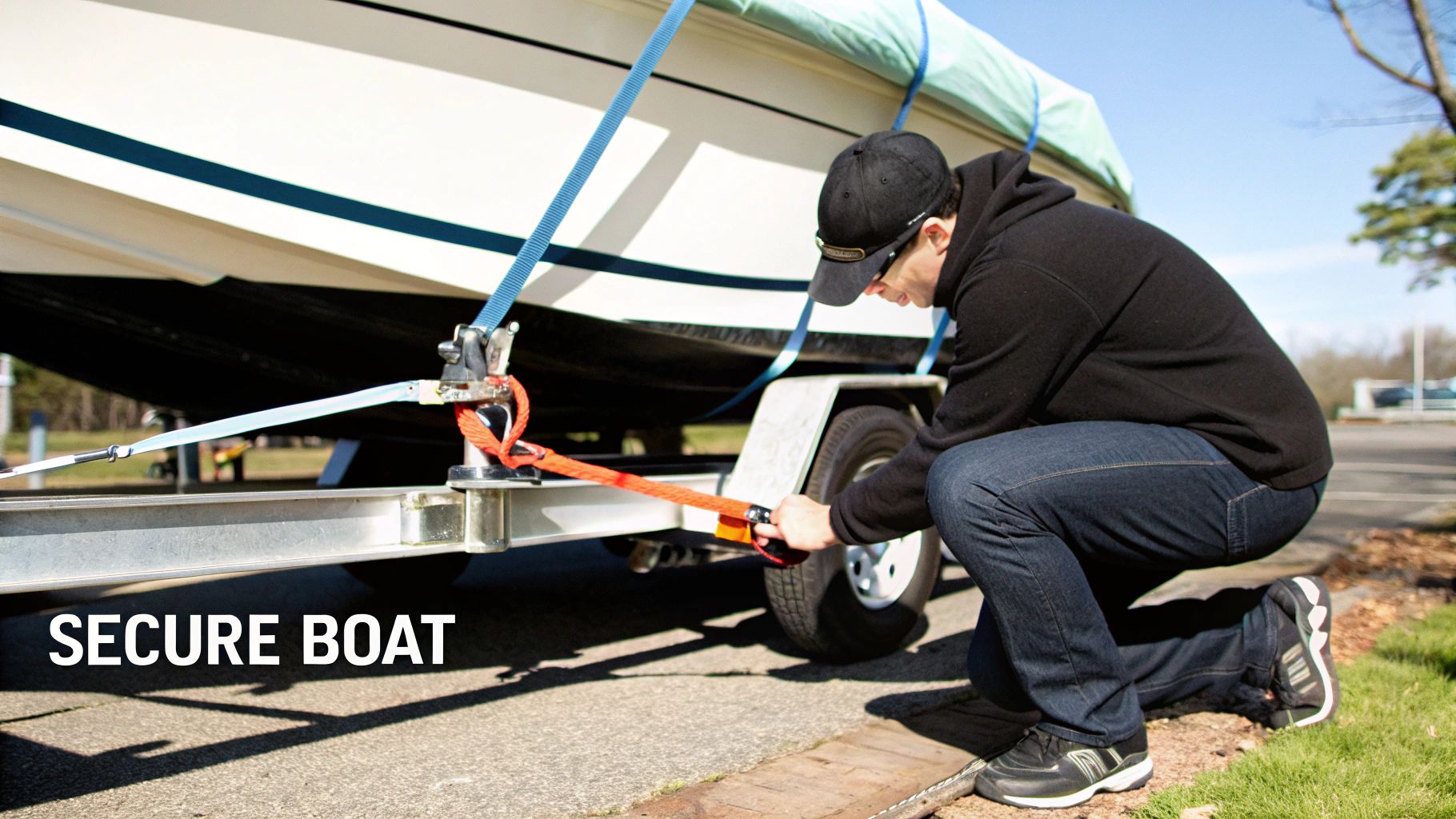
Getting your boat onto the trailer feels like a big win, but don't pull up the ramp just yet. Your next move is absolutely critical: making sure the boat is perfectly centered on the bunks. A boat that's even slightly off-kilter isn't just an eyesore; it's a serious towing hazard.
This kind of uneven weight distribution is a classic recipe for dangerous trailer sway, especially at highway speeds. Worse yet, it concentrates the boat's entire weight onto a few small pressure points on the hull. Over time, that stress can lead to expensive gelcoat cracks or even structural damage. A few extra moments spent on alignment now can save you a world of headache later.
Using Visual Cues for Perfect Alignment
Your trailer’s guide-ons are your best friends during this step. As the boat glides onto the trailer, keep your eyes locked on those vertical posts. The goal is simple: maintain the same amount of space between your hull and the guide-on for both the port and starboard sides.
If you’re driving the boat on, a gentle "bump" of the throttle can help nudge the bow into place. It’s a delicate dance, so use small, deliberate steering inputs until everything looks symmetrical. Think finesse, not force.
The ultimate gut check is the gap between your hull and the trailer bunks themselves. Lean over and look down both sides of the trailer. You should see a consistent, even space. If one side is pressed tight against the bunk while the other has a wide gap, you need to adjust.
Making Adjustments in the Water
So, what do you do if you notice the stern is kicked out to one side after you've winched up? First, don't panic. And whatever you do, don’t drag it all the way up the ramp like that. The water is your greatest ally for making corrections.
Just have your driver back the trailer down the ramp by a few feet—only enough for the stern of the boat to become slightly buoyant again. This lifts the hull just enough to relieve the friction, letting you easily push or pull the stern back into its proper position in the middle of the bunks.
Once it looks right, give the winch one final crank to pull the bow snug against the bow stop, then pull forward slowly and smoothly. This little trick saves you from the back-breaking work of trying to manhandle a multi-ton boat on dry land.
Properly seating the boat on its bunks or rollers is fundamental to ensure the weight distribution matches the trailer’s design, which you can learn more about through insights into the boat trailer market. This final check ensures your boat is supported correctly for the road, protecting your investment and keeping you safe on the journey home.
Securing Your Boat for the Drive Home
Your boat is on the trailer, but don't even think about hitting the road yet. The job isn't done until you've performed a few crucial final steps. Pull away from the busy ramp into a designated staging area. This is where you'll make your rig road-ready and ensure your prized possession gets home safely.
First things first, let's go back to the bow. Give that winch handle a few more solid cranks. You want the boat’s bow pulled up good and snug against the trailer’s bow stop or roller. There should be absolutely zero daylight between them.
With the winch tight, immediately hook up the safety chain. Think of this as your fail-safe. Loop the chain from the trailer post to the boat's bow eye. It needs to be tight, but not so tight that it’s taking the load—that's the winch strap's job. Just make sure it’s not loose enough to drag on the pavement.
Stop the Bounce with Transom Straps
Now, head to the back of the boat. It's time to deal with the transom straps, and these are absolutely essential. Without them, your boat's stern will bounce on the trailer with every pothole and frost heave you hit. That constant slamming puts a ton of stress on your hull.
Here’s how to get them right:
- Hook It Up: Connect one end of the strap to a solid point on the trailer frame and the other to your boat's transom tie-down U-bolts.
- Get the Right Angle: You're looking for a 45-degree angle. This magic number pulls the boat both down and forward, locking it onto the bunks and preventing it from shifting around.
- Crank It Down: Ratchet the straps until they are drum-tight. You're trying to make the boat and trailer feel like a single, solid piece of equipment.
A mistake I see all the time at the ramp is people running their transom straps almost straight up and down or straight back. That seriously compromises how effective they are. It’s that diagonal pull that really pins the boat down and stops it from bouncing or swaying.
The Final Walk-Around Check
With the main straps cinched down, it's time for one last walk-around to button everything else up.
Tilt your outboard motor up and engage the transom saver. This simple bracket braces the engine against the trailer, taking the strain off your boat's transom and the motor's hydraulic trim system during the bumpy ride home. It's cheap insurance.
Don't forget to put the drain plug back in! It's easy to overlook when you're focused on everything else, but you'll be glad you remembered next time you launch.
Next, do a quick sweep of the boat's interior. Secure any loose gear like coolers, tackle boxes, or life jackets so they don't become high-speed projectiles on the highway. A few extra straps or even sturdy dock lines can work wonders for tying down bulky items. If you're curious about what lines to have on hand, you can read our guide on selecting dock lines.
Finally, plug your trailer's lights into your tow vehicle. Have a buddy confirm your running lights, brake lights, and turn signals are all working. Today's boat trailers have come a long way, with features like torsion axles and sealed LED lighting, but they still need a quick function check. As you can learn on imarcgroup.com, trailer technology has evolved, but the need for a careful, final check has never changed.
Answering Your Top Boat Loading Questions
Even seasoned boaters run into head-scratchers at the ramp. Weird currents, a new trailer, or just an off day can turn a routine task into a puzzle. Knowing the answers to the most common loading questions means you can troubleshoot on the fly and get back on the road without the stress.
Think of this as your field guide for those "what if" moments. The more you understand the physics of your boat and trailer working together, the faster you can spot and solve any problem that comes your way.
How Deep Should My Trailer Be in the Water?
This is probably the most common question I hear, and the honest answer is: it depends entirely on your trailer. The classic rookie mistake is backing in way too deep. You want the trailer to actively guide the boat onto the bunks or rollers, not just let it float around on top of them.
- For Bunk Trailers: A great rule of thumb is to submerge the bunks about two-thirds of their length. The tops of your trailer fenders should be sitting high and dry, well above the water. This depth creates a V-shape with the bunks that forces your boat’s keel to find the center line as you move forward.
- For Roller Trailers: You have a bit more wiggle room here. Rollers are designed to physically center the hull as you load, so you can often back in a little deeper than you would with bunks.
The water is your assistant, but don't let it take over. If your boat is floating freely above the bunks, you're in too deep. The trailer has lost its ability to align the hull, and you’ll likely end up crooked.
What's the Easiest Way to Straighten a Crooked Boat?
First off, resist the urge to drag it all the way up the ramp. Trying to muscle a crooked, multi-ton boat on dry bunks is a recipe for frustration and a strained back. The fix is surprisingly simple: let the water do the work for you.
Just have your driver ease the trailer back down the ramp a couple of feet. You only need to go back until the stern just starts to float. That little bit of buoyancy is all it takes to lift the hull, break the friction, and let you shove the stern back to the center with minimal effort. Once it's straight, snug up the winch and pull out of the water. Easy.
Should I Drive On or Winch My Boat?
Ah, the great ramp debate. Honestly, there's no single "best" method. It really comes down to the ramp's rules, the conditions of the day, and what you're comfortable with. They are just different techniques for the same goal.
Driving on is fast, there's no doubt. But it takes a lot of practice to do it smoothly and safely. It also creates "prop wash," a powerful jet of water from your propeller that can scour out a big hole at the base of the ramp. This is a huge problem for ramp maintenance, which is why it's banned at many lakes. If you're having trouble with this, you might want to learn how to pick the right boat propeller, since your prop can significantly impact low-speed maneuverability.
Winching, on the other hand, is the slow-and-steady approach. It's deliberate, far safer, and gives you complete control, which is a lifesaver when you're fighting wind or a nasty cross-current. Many of the most experienced boaters I know use a hybrid technique: they’ll gently drive the boat about 90% of the way onto the trailer, then kill the engine and use the winch to crank it the last few feet until it's snug against the bow stop.
At Boating Articles, we're committed to giving you the practical knowledge to make every trip to the water a success. For more expert guides, reviews, and DIY tips, visit us at https://boating-articles.com.
